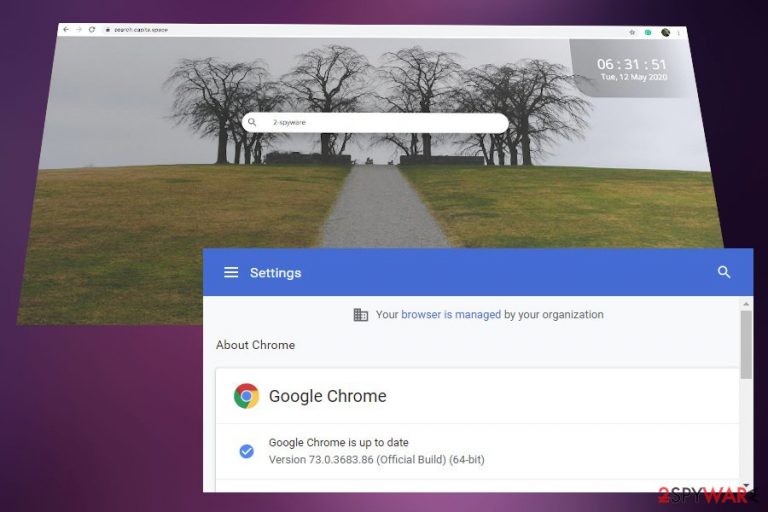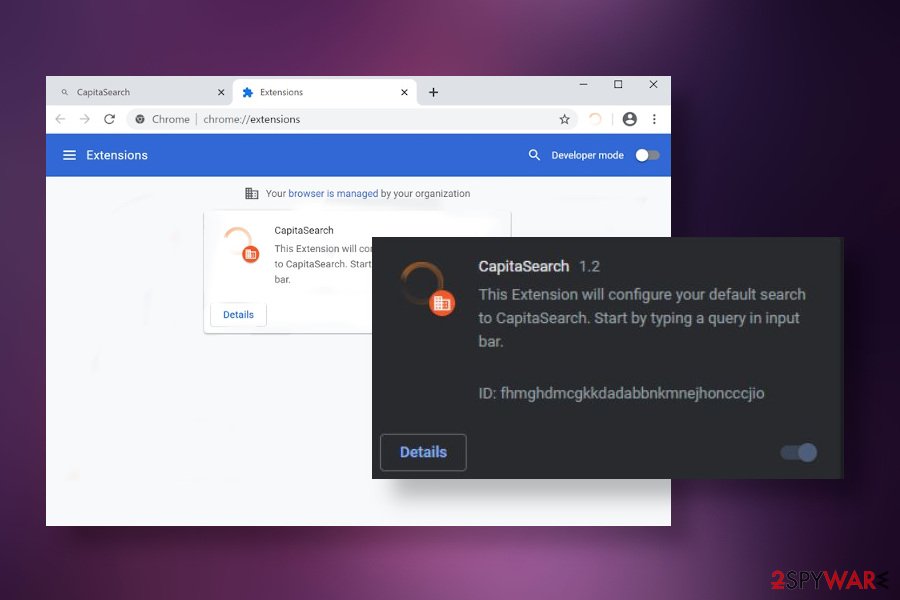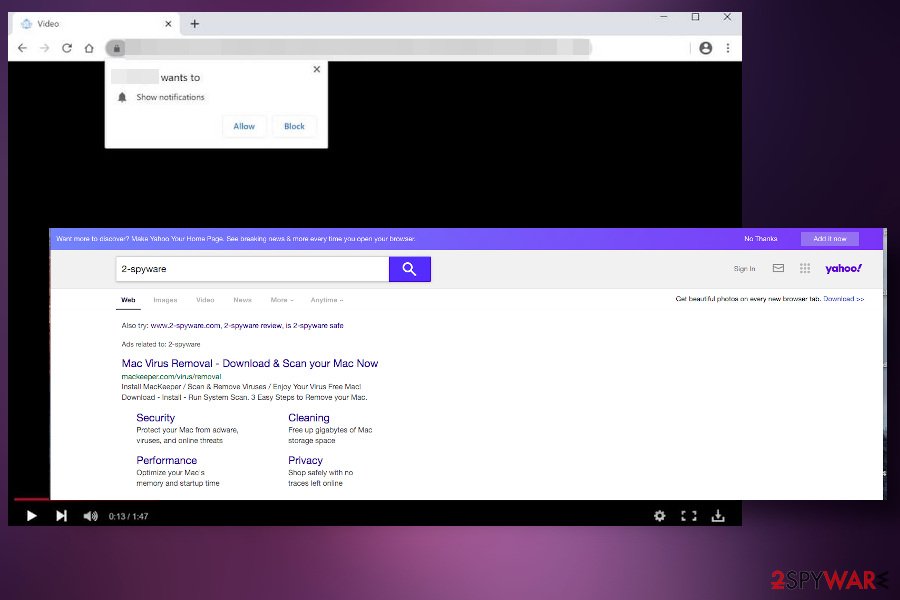CapitaSearch (Chrome, Firefox, IE, Edge) - updated Jun 2020
CapitaSearch Removal Guide
What is CapitaSearch?
CapitaSearch is a particular search engine that generates deceiving material

CapitaSearch is an intrusive browser hijacker that triggers redirects to sponsored content on the Yahoo engine after making multiple setting changes on the web browser. As a potentially unwanted program (PUP)[1], it spreads in the disguise of other free programs and manages to infiltrate the default web browser without being noticed. It exhibits compatibility with Google Chrome, Mozilla Firefox, Microsoft Edge, Internet Explorer, Safari, and other web browsers. In other words, it may set search.capita.space search engine, the start window, drop various toolbars, change the new tab window, and initiate other unapproved modifications.
To ensure the prevalence, the virus can set “Managed by your organization” policies on Chrome. The alteration of management policies allows third-party tools like this one to take full control over the web browser's settings. Consequently, Chrome is set to launch the search.capita.space search engine by default and prevent its removal. Moreover, these settings may automatically download unwanted third-party extensions that may subsequently display popups or trigger redirects.
| Name | CapitaSearch |
| Type | Browser hijacker, Potentially Unwanted Program (PUP) |
| Related | search.capita.space search engine, 'Managed by your organization' Chrome settings enabled |
| Compatibility | Google Chrome, Mozilla Firefox, Microsoft Edge, Internet Explorer, Safari, etc. |
| Distribution | This misleading search engine takes advantage of the infamous software bundling distribution strategies. It spreads hidden under freeware Quick installation set up as a pre-selected item and expects the user to fail to recognize it |
| Symptoms | The main symptom is related to changes in the web browser: modified start page, search engine, new tab window, etc. Besides, it may trigger sponsored links within search results, commercial pop-up ads, browser's redirects, and similar side effects |
| Task | The virus seeks to promote affiliate websites, spread malware, distort visitors' traffic, collect browsing-related information about people, and similar. |
| Danger | The browser-based plug-ins is not dangerous. Its functionality and goals are marketing oriented, though there is a potential risk of downloading malware |
| Removal | Manual removal of a browser hijacker is possible, though not recommended. Due to the distribution of bundling, there's a high probability that there are many PUPs on the system. Therefore, a scan with a reputable anti-virus is recommended |
| Malware damage | PUPs initiate various changes within web browsers. However, they are also capable of distorting the system's settings and files, which is why experts recommend optimizing the system's performance after malware removal. For that, we recommend using FortectIntego |
The CapitaSearch hijacker exhibits the typical behavior of a browser hijacker. It replaces the start page, search site, new tab window, and generates other web browser modifications without explicitly asking for a user’s consent. Besides, it stealthily uses tracking cookies to spy on a user’s web browsing activities.
If you have a suspicion that a search engine virus infected your PC, the most typical symptoms you should be encountering are the following:
- The default search engine was replaced by search.capita.space
- New tab URL and the start page replaced by this domain or other unknown website
- New web browser plug-ins added
- Suspicious links positioned within search results
- Sponsored Yahoo search results displayed
- Web browser’s redirects keep disrupting activities
- Misleading ads positioned on any website that you visit, etc.
Although posing a minimal risk, CapitaSearch is closely related to adware and other malware, meaning that its purpose is to gain profit from advertisements and web traffic. This browser hijacker has an in-built database of domains to promote; therefore, your web browser will continuously redirect to websites that you are not willing to visit.
Moreover, it may generate various ads, pop-ups, banners, and hyperlinks on random websites, which not only cover the content that you want to see but also redirect to dubious third-party websites. Keep in mind that the redirect virus may be involved in PUP distribution and regularly reroute your web browser to malware download websites.
Data harvesting is yet another reason for the proper unwanted program removal. The plug-in that it drops is accompanied by tracking cookies[2], which settle within each browser installed on the system and start collecting the following entries:
- Search queries
- Websites visited
- IP address
- Technical details of the web browser
- E-mail address
- Geolocation
Although data collected is non-personally identifiable, sharing it with third parties is not advisable as they may use it for improving advertising strategies and providing users with more appealing content. Unfortunately, those ads and promoted websites are of no use to the user.
In addition to the aforementioned browser changes, CapitaSearch enables the 'Managed by your organization' Chrome feature. Due to this, the web browser generates a pop-up window stating that Google Chrome is managed by the organization and prevents the user from modifying settings manually. This setting is established to enable certain Chrome parameters on workplace PC. However, third-party apps, including browser hijackers, can take control over various policies and start managing Chrome in the disguise of an organization.
It is possible to disable 'Managed by your organization' feature by accessing Chrome's settings, clicking on the dots at the bottom of the drop-down menu, and selecting disable. However, the parameters will be restored once you restart the web browser. Therefore, it's important to remove CapitaSearch virus in the first place.

Proper CapitaSearch removal requires a full system scan with a reliable anti-malware program. Since this ad-supported application spreads by bundling, usually it gets installed along with adware or PUPs.
According to NoVirus.uk[3] experts, malware can significantly decrease the web browser's performance, affect download speed, corrupt boot-up processes injected addition Windows registry entries. The virus removal can fix almost all web browsing-related issues. However, malware elimination is not sufficient to restore the system to the pre-malware state. Thus, it is also advisable to perform PC's recovery with a tool like FortectIntego.
CapitaSearch removal can stop the unwanted behavior completely
Upon the release of the Chrome 73 version, users started reporting an unseen statement “Managed by your organization” within the drop-down settings menu. This notification means that the organization that owns the machine you are working with is managing Chrome's settings. That's a common policy management feature used by many Enterprise admins.
However, the same “Managed by your organization” notification can occur on home PCs and Macs leaving the users confused. The problem is not the message itself, but rather the behavior of the Chrome browser as it may display unwanted search engine, start page, new tab window, prevent the elimination of unwanted extensions, and similar.
The problem is that malware can also use Chrome policies to force install malicious extensions, disable safe browsing, Incognito mode, and other behavior. The virus is misusing the “Managed by your organization” policy management feature as well, which is why people are not able to delete related extensions or the search itself.

People keep reporting on Reddit[4] and Chrome support[5] websites that their accounts are managed by Capita Search extension, which cannot be removed. Those who have fallen in this situation should follow these steps to disable the “Managed by your organization” feature and eliminate malware:
- Press Windows key + R, type regedit, and press Enter.
- Navigate to the following directory:
HKEY_LOCAL_MACHINE\SOFTWARE\Policies\Google\Chrome
- If you see an Extensions tab, force the process to open and delete it.
- Eliminate all non-default entries installed by third parties.
- Scan the machine with an anti-malware tool to delete PUPs.
- Reset Chrome's settings.
Freeware installations lead to problems with the security
We must admit that some freeware turns out to be handy tools for improving web browsing performance and everyday activities. However, downloading them recklessly just for trying is dangerous because those free programs are frequently used for PUP dissemination.
Freeware developers earn a commission fee for every add-on, plug-in, toolbar, or whatnot that is installed to users' PCs as an additional component. Thus, it may be presumed that every third free app on third-party download websites contains additional pre-checked items.
Luckily, unpacking the bundle is not difficult. All you have to do is to opt for the Advanced or Custom installation option and monitor the process carefully. When a setup window stating that you agree with the installation of browser-based plug-ins emerges, untick the checkbox before clicking the Next button. That's it. The freeware will be installed PUP-free.
In addition, you should be cautious when browsing the net, especially when some ads redirect you to unknown websites. Third-party domains may be involved in PUP distribution and contain click-to-download ads.

CapitaSearch hijacking can be stopped with anti-malware tools
Seeing that the web browser's settings have been altered without your permission is an indication of a browser hijacker's attack. Do not underestimate the capabilities of a reliable-looking third-party search engine or new tab window. They may be set to promote dangerous content, display links to phishing websites, or initiate other campaigns to gain whatever profit they need. Having this in mind, the virus removal should not be postponed.
The only reliable way to remove CapitaSearch malware from the system is to run a scan with an anti-malware tool. Upon that, delete suspicious plug-ins from a web browser or, at best, reset the browser's settings. If, however, you prefer manual removal, rely on a guide submitted by our security experts.
You may remove virus damage with a help of FortectIntego. SpyHunter 5Combo Cleaner and Malwarebytes are recommended to detect potentially unwanted programs and viruses with all their files and registry entries that are related to them.
Getting rid of CapitaSearch. Follow these steps
Uninstall from Windows
Instructions for Windows 10/8 machines:
- Enter Control Panel into Windows search box and hit Enter or click on the search result.
- Under Programs, select Uninstall a program.

- From the list, find the entry of the suspicious program.
- Right-click on the application and select Uninstall.
- If User Account Control shows up, click Yes.
- Wait till uninstallation process is complete and click OK.

If you are Windows 7/XP user, proceed with the following instructions:
- Click on Windows Start > Control Panel located on the right pane (if you are Windows XP user, click on Add/Remove Programs).
- In Control Panel, select Programs > Uninstall a program.

- Pick the unwanted application by clicking on it once.
- At the top, click Uninstall/Change.
- In the confirmation prompt, pick Yes.
- Click OK once the removal process is finished.
Delete from macOS
Remove items from Applications folder:
- From the menu bar, select Go > Applications.
- In the Applications folder, look for all related entries.
- Click on the app and drag it to Trash (or right-click and pick Move to Trash)

To fully remove an unwanted app, you need to access Application Support, LaunchAgents, and LaunchDaemons folders and delete relevant files:
- Select Go > Go to Folder.
- Enter /Library/Application Support and click Go or press Enter.
- In the Application Support folder, look for any dubious entries and then delete them.
- Now enter /Library/LaunchAgents and /Library/LaunchDaemons folders the same way and terminate all the related .plist files.

Remove from Microsoft Edge
Delete unwanted extensions from MS Edge:
- Select Menu (three horizontal dots at the top-right of the browser window) and pick Extensions.
- From the list, pick the extension and click on the Gear icon.
- Click on Uninstall at the bottom.

Clear cookies and other browser data:
- Click on the Menu (three horizontal dots at the top-right of the browser window) and select Privacy & security.
- Under Clear browsing data, pick Choose what to clear.
- Select everything (apart from passwords, although you might want to include Media licenses as well, if applicable) and click on Clear.

Restore new tab and homepage settings:
- Click the menu icon and choose Settings.
- Then find On startup section.
- Click Disable if you found any suspicious domain.
Reset MS Edge if the above steps did not work:
- Press on Ctrl + Shift + Esc to open Task Manager.
- Click on More details arrow at the bottom of the window.
- Select Details tab.
- Now scroll down and locate every entry with Microsoft Edge name in it. Right-click on each of them and select End Task to stop MS Edge from running.

If this solution failed to help you, you need to use an advanced Edge reset method. Note that you need to backup your data before proceeding.
- Find the following folder on your computer: C:\\Users\\%username%\\AppData\\Local\\Packages\\Microsoft.MicrosoftEdge_8wekyb3d8bbwe.
- Press Ctrl + A on your keyboard to select all folders.
- Right-click on them and pick Delete

- Now right-click on the Start button and pick Windows PowerShell (Admin).
- When the new window opens, copy and paste the following command, and then press Enter:
Get-AppXPackage -AllUsers -Name Microsoft.MicrosoftEdge | Foreach {Add-AppxPackage -DisableDevelopmentMode -Register “$($_.InstallLocation)\\AppXManifest.xml” -Verbose

Instructions for Chromium-based Edge
Delete extensions from MS Edge (Chromium):
- Open Edge and click select Settings > Extensions.
- Delete unwanted extensions by clicking Remove.

Clear cache and site data:
- Click on Menu and go to Settings.
- Select Privacy, search and services.
- Under Clear browsing data, pick Choose what to clear.
- Under Time range, pick All time.
- Select Clear now.

Reset Chromium-based MS Edge:
- Click on Menu and select Settings.
- On the left side, pick Reset settings.
- Select Restore settings to their default values.
- Confirm with Reset.

Remove from Mozilla Firefox (FF)
Remove dangerous extensions:
- Open Mozilla Firefox browser and click on the Menu (three horizontal lines at the top-right of the window).
- Select Add-ons.
- In here, select unwanted plugin and click Remove.

Reset the homepage:
- Click three horizontal lines at the top right corner to open the menu.
- Choose Options.
- Under Home options, enter your preferred site that will open every time you newly open the Mozilla Firefox.
Clear cookies and site data:
- Click Menu and pick Settings.
- Go to Privacy & Security section.
- Scroll down to locate Cookies and Site Data.
- Click on Clear Data…
- Select Cookies and Site Data, as well as Cached Web Content and press Clear.

Reset Mozilla Firefox
If clearing the browser as explained above did not help, reset Mozilla Firefox:
- Open Mozilla Firefox browser and click the Menu.
- Go to Help and then choose Troubleshooting Information.

- Under Give Firefox a tune up section, click on Refresh Firefox…
- Once the pop-up shows up, confirm the action by pressing on Refresh Firefox.

Remove from Google Chrome
Delete malicious extensions from Google Chrome:
- Open Google Chrome, click on the Menu (three vertical dots at the top-right corner) and select More tools > Extensions.
- In the newly opened window, you will see all the installed extensions. Uninstall all the suspicious plugins that might be related to the unwanted program by clicking Remove.

Clear cache and web data from Chrome:
- Click on Menu and pick Settings.
- Under Privacy and security, select Clear browsing data.
- Select Browsing history, Cookies and other site data, as well as Cached images and files.
- Click Clear data.

Change your homepage:
- Click menu and choose Settings.
- Look for a suspicious site in the On startup section.
- Click on Open a specific or set of pages and click on three dots to find the Remove option.
Reset Google Chrome:
If the previous methods did not help you, reset Google Chrome to eliminate all the unwanted components:
- Click on Menu and select Settings.
- In the Settings, scroll down and click Advanced.
- Scroll down and locate Reset and clean up section.
- Now click Restore settings to their original defaults.
- Confirm with Reset settings.

Delete from Safari
Remove unwanted extensions from Safari:
- Click Safari > Preferences…
- In the new window, pick Extensions.
- Select the unwanted extension and select Uninstall.

Clear cookies and other website data from Safari:
- Click Safari > Clear History…
- From the drop-down menu under Clear, pick all history.
- Confirm with Clear History.

Reset Safari if the above-mentioned steps did not help you:
- Click Safari > Preferences…
- Go to Advanced tab.
- Tick the Show Develop menu in menu bar.
- From the menu bar, click Develop, and then select Empty Caches.

After uninstalling this potentially unwanted program (PUP) and fixing each of your web browsers, we recommend you to scan your PC system with a reputable anti-spyware. This will help you to get rid of CapitaSearch registry traces and will also identify related parasites or possible malware infections on your computer. For that you can use our top-rated malware remover: FortectIntego, SpyHunter 5Combo Cleaner or Malwarebytes.
How to prevent from getting browser hijacker
Choose a proper web browser and improve your safety with a VPN tool
Online spying has got momentum in recent years and people are getting more and more interested in how to protect their privacy online. One of the basic means to add a layer of security – choose the most private and secure web browser. Although web browsers can't grant full privacy protection and security, some of them are much better at sandboxing, HTTPS upgrading, active content blocking, tracking blocking, phishing protection, and similar privacy-oriented features. However, if you want true anonymity, we suggest you employ a powerful Private Internet Access VPN – it can encrypt all the traffic that comes and goes out of your computer, preventing tracking completely.
Lost your files? Use data recovery software
While some files located on any computer are replaceable or useless, others can be extremely valuable. Family photos, work documents, school projects – these are types of files that we don't want to lose. Unfortunately, there are many ways how unexpected data loss can occur: power cuts, Blue Screen of Death errors, hardware failures, crypto-malware attack, or even accidental deletion.
To ensure that all the files remain intact, you should prepare regular data backups. You can choose cloud-based or physical copies you could restore from later in case of a disaster. If your backups were lost as well or you never bothered to prepare any, Data Recovery Pro can be your only hope to retrieve your invaluable files.
- ^ "PUPs" - Potentially Unwanted Programs FAQ. Google Support. Frequently Asked questions.
- ^ Michal Wlosik, Michael Sweeney. What’s the Difference Between First-Party and Third-Party Cookies?. Clear Code. Online advertising and analytics.
- ^ Virus and Spyware News. NoVirus. Virus and spyware news.
- ^ Has anyone heard of CapitaSearch?. Reddit. The biggest collection of forums.
- ^ My account has been hijacked by Capita Search and It won't let me get rid of the extension. Google. Official Google's support site.
